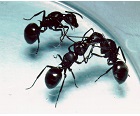なぜ協力するのか?血縁のない個体どうしの協力行動の進化を明らかにする

メンバー: 佐藤俊幸、小山哲史
分野: 基礎生物学、神経科学、動物生命科学
所属: 農学研究院動物生命科学
キーワード: 進化、行動生態、社会性昆虫、アリ、ミツバチ、利他行動
ウェブサイト:
研究概要

無脊椎動物における非血縁者間の協力行動の研究は、脊椎動物とは独立に進化した現象として、協力行動・社会性の進化の普遍的な原理を理解するうえで、重要な示唆を与えるものと期待される。チクシトゲアリは血縁のない創設女王どうし同じ営巣場所で越冬し、栄養交換・共同育児しコロニーを創設するが、成熟したコロニーでは単女王となり、女王は攻撃的になる(Sasaki et al.1996; Sasaki et al.2005) 。
本研究では、血縁のない創設女王どうしの協力行動の適応的意義を飼育実験と行動観察により明らかにする。コロニー内血縁構造を解析し、女王の包括適応度、協力行動が維持される条件を明らかにする。また、どのようなメカニズムで女王の行動が協力から敵対へとスイッチするのか、その生理学的機序も明らかにする。脊椎動物における研究との比較も可能となり、互恵的利他行動に関する普遍的な原理を明らかにする。
*この研究は課題番号25450483 基盤研究(C)「チクシトゲアリ創設女王どうしの協力行動の適応的意義と生体アミンが行動に与える影響」(平成25年度~平成28年度)、及びJAMBIOプロジェクトNo.25-45の助成を受けています。
主要論文・参考事項
1. S.Koyama, S. Matsui, T. Satoh & K. Sasaki (in press) Octopamine and cooperation: octopamine regulates the disappearance ofcooperative behaviours between genetically unrelated founding queens in the ant. Biology Letters.
2. Y. Nishide, T. Satoh, K. Murase, C. E. Thomas and K. Iwabuchi (2014) Genotype-based recognition among individuals of the social insect Pristomyrmex punctatus (Japanese queenless ant) from geographically divergent populations. Journal of Insect Behavior, 27(1), pp 117-126.
3. A. Hashimoto, K. Sasaki, S. Koyama, T. Satoh (2013) Food exchange behavior between multiple founding queens of Polyrhachismoesta (Hymenoptera: Formicidae) changes during hibernation. Appl. Entomol. Zool., 48, 141-145.
4. Y. Nishide, T. Satoh, K. Murase, C. E. Thomas and K. Iwabuchi (2012) Do Japanese Queenless Ants Pristomyrmex punctatus (F. Smith) Exhibit Genotype-based Kin Recognition. Journal of Insect Behavior, 25(2), 137-142.
5. Nishide Y., Satoh T., Hiraoka T., Obara Y., Iwabuchi K. (2007) Clonal structure affects the assembling behavior in the Japanese queenless ant Pristomyrmex punctatus. Naturwissenschaften, 94(10), 865-869.
6. Sasaki K., Jibiki E., Satoh T. and Obara Y. (2005) Queen phenotype and behaviour during cooperative colony founding in Polyrhachis moesta. Insectes Sociaux, 52(1), 19-25.
7. Sasaki K., Satoh T. and Obara Y. (1996) The cooperative foundation of colonies by unrelated foundress in the ant, Polyrhachis moesta. Insectes Sociaux, 43(2), 217-226.
8. Satoh T. (1991) Behavioral differences of queens in monogynous and polygynous nests of Camponotus nawai complex. Insectes Sociaux, 38(1), 37-44.
お問い合わせ先
東京農工大学・先端産学連携研究推進センター
urac[at]ml.tuat.ac.jp([at]を@に変換してください)
Why cooperate? : evolution of cooperation between genetically unrelated individuals

Research members: Dr. Toshiyuki SATOH, Dr. Satoshi KOYAMA
Research fields: Basic biology, Neuroscience, Animal life science
Departments: Division of Animal Life Science, Institute of Agriculture
Keywords: evolution, behavioral ecology, social insects, ants, honeybee, altruistic behavior
Web site:
Summary

Researches for cooperative behavior between unrelated individuals in invertebrates are very important to understand the evolution of social behaviors in general. In an ant species Polyrhachis moesta, unrelated founding queens often cooperate to found a colony, however, matured colonies always have single queens, and those queens are hostile each other (Sasaki et al.1996; Sasaki et al.2005).
In this study, our final goal is to clarify the proximate and ultimate cause of such cooperation with genetically unrelated individuals.
*This study is supported by JSPS KAKENHI grant no. 25450483 and JAMBIO project No. 25–45.
Reference articles and patents
1. S.Koyama, S. Matsui, T. Satoh & K. Sasaki (in press) Octopamine and cooperation: octopamine regulates the disappearance ofcooperative behaviours between genetically unrelated founding queens in the ant. Biology Letters.
2. Y. Nishide, T. Satoh, K. Murase, C. E. Thomas and K. Iwabuchi (2014) Genotype-based recognition among individuals of the social insect Pristomyrmex punctatus (Japanese queenless ant) from geographically divergent populations. Journal of Insect Behavior, 27(1), pp 117-126.
3. A. Hashimoto, K. Sasaki, S. Koyama, T. Satoh (2013) Food exchange behavior between multiple founding queens of Polyrhachismoesta (Hymenoptera: Formicidae) changes during hibernation. Appl. Entomol. Zool., 48, 141-145.
4. Y. Nishide, T. Satoh, K. Murase, C. E. Thomas and K. Iwabuchi (2012) Do Japanese Queenless Ants Pristomyrmex punctatus (F. Smith) Exhibit Genotype-based Kin Recognition. Journal of Insect Behavior, 25(2), 137-142.
5. Nishide Y., Satoh T., Hiraoka T., Obara Y., Iwabuchi K. (2007) Clonal structure affects the assembling behavior in the Japanese queenless ant Pristomyrmex punctatus. Naturwissenschaften, 94(10), 865-869.
6. Sasaki K., Jibiki E., Satoh T. and Obara Y. (2005) Queen phenotype and behaviour during cooperative colony founding in Polyrhachis moesta. Insectes Sociaux, 52(1), 19-25.
7. Sasaki K., Satoh T. and Obara Y. (1996) The cooperative foundation of colonies by unrelated foundress in the ant, Polyrhachis moesta. Insectes Sociaux, 43(2), 217-226.
8. Satoh T. (1991) Behavioral differences of queens in monogynous and polygynous nests of Camponotus nawai complex. Insectes Sociaux, 38(1), 37-44.
Contact
University Research Administration Center(URAC),
Tokyo University of Agriculture andTechnology
urac[at]ml.tuat.ac.jp
(Please replace [at] with @.)

